

After the 2015 governmental beef ban destroyed jobs of leather workers from Dalit and Muslim communities in India, artist activist Sudheer Rajbhar searched for a material that could replace leather and start activities for all these artisans. In 2017, a recycled rubber material made from waste—really close to leather in its feeling properties emerged as the heart of Chamar Studio. Founded in 2018, the practice emerges from contemporary art and arrives at design through the quest for caste equality and the end of discrimination. A cooperative of cobblers who would stitch together bags designed by Sudheer, Chamar creations and collections are activism flags of different realities of social injustice in India.
Name of the firm: Chamar Studio
Product Range: Re-Rubber (Recycle Rubber Products)
Vision: From and for courageous people who defy conventions, Chamar aims to shift traditional social vision tied to the Untouchables by lending prestige to Dalit community through excellence of crafts.
What does sustainable design mean to you?
To me, sustainable design refers to the practice of creating systems that promote long-term ecological balance. It involves preserving centuries-old savoir-faire from extinction, preventing waste and over production, going against the culture of encouraging people to want increased newness at rapid speed and the creation of environments that foster equity and community engagement.
Are your products made from non-toxic, natural, or recycled materials?
We work with recycled rubber from industry leftovers or discarded materials, cotton, and thick canvas. All our products are cruelty free, waterproof and lifetime objects.
How can social norms encourage sustainable design?
Social norms play a crucial role in shaping individual behavior and collective actions. By aligning social norms with sustainable design principles, we can promote environmentally friendly practices and encourage a more sustainable future. Here are some ways in which social norms can contribute to encouraging sustainable design.
Creating a culture of sustainability, social norms can help establish sustainability as a cultural value. By promoting a mindset that values and prioritizes sustainable design, individuals are more likely to adopt and support environmentally conscious practices.
What have been some of the biggest challenges to your commitment to sustainable design?
One of the significant challenges is a lack of awareness and understanding of sustainable design principles among designers, clients, and the public. Many people are not familiar with sustainable practices and their potential benefits. While sustainable design practices are gaining traction, there is still a need for scalability and accessibility. Scaling sustainable solutions across different projects, industries, and regions can be challenging due to varying contexts, local regulations, and infrastructure limitations. Sustainable design requires considering the entire life cycle of a product or project, including material sourcing, manufacturing, use, and end-of-life disposal. Balancing environmental impact throughout the life cycle can be complex and requires collaboration. Overcoming these challenges requires collaborative efforts from Artist, designers, policymakers, manufacturers, and consumers to drive awareness, education, and innovation in sustainable design practices.
What is on deck for the next six months within your design practice?
As we create only one collection per year, I want to introduce a personalization service where people can request a creation of their own bag design out of our iconic models. The idea would be that if someone wants a very personal bags for a reason, or wants to upcycle their own item’s material to make it more personal, like a grandmother’s embroidery on a bed linen, etc.—I seek for more interaction and individual shared stories with the people coming to us for long lasting bags, so they can make Chamar their own. I plan to also continue expanding on the areas we experiment on such as spaces, and plan to push forward the Haveli Chamar project I started in Rajasthan.
In this home designed by Sonal R Mutha and Aniketh Bafna, founders and principal designers…
Essentia Home’s journey in redefining luxury interiors took a bold new step as it opened…
Retail design is a balancing act. Between creating spaces that attract and those that sell,…
A few days ago, I found myself navigating an unfamiliar (for me) corner of Delhi—Vasant…
Jugal Mistri, Founder & Principal Architect, JMA Mumbai, sees mood boarding as an evolving narrative…
For Rachna Agarwal, Founder and Design Ideator, Studio IAAD, mood boards serve as a bridge…